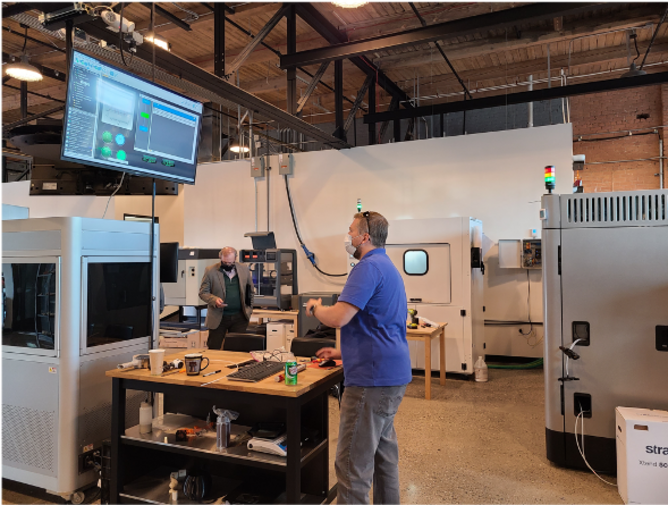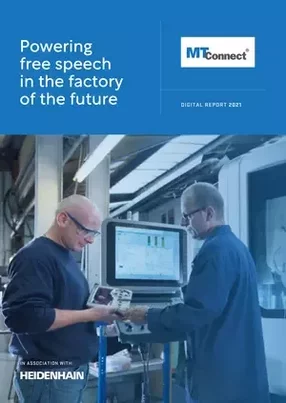MTConnect: Powering free speech in the factory of the future
The factory of the future will depend on seamless communication between devices, and this is exactly what not-for-profit organisation MTConnect Institute is offering.
“Data is the new oil in a factory,” said Dr Stephan Biller, CEO of Advance Manufacturing International (AMI) and Trustee of MTConnect, who outlines how the company is helping to create connected factories through their common device language and communication.
MTConnect is an open, royalty-free standard that provides a semantic vocabulary for manufacturing devices. In practice, it is used for factory floor monitoring, Overall Equipment Effectiveness (OEE) calculation, predictive analytics or maintenance, manufacturing cell integration, scheduling and routing, and Enterprise Resource Planning (ERP) integration.
“The factory of the future depends on stronger communication among devices, speaking freely which is what MTConnect offers,” said Biller who pointed out the systems allow machines within manufacturing to know what other machines are doing - whether they are on-site or thousands of miles away in another part of the US.
“Key performance indicators (KPIs) in a factory include productivity, quality, costs, on-time delivery, sustainability, and safety. MTConnect’s tools will create a seamless environment and resilient future which will help reduce energy, such as water or heating, and improve the sustainable footprint of a factory,” said Biller.
In essence, MTConnect is building its success on the following attributes:
- Simple
- Free
- Open
- Powerful
MTConnect has been developed by the industry and supported by AMT – The Association for Manufacturing Technology which is focused on promoting the MTConnect Standard. “As a member of the board of trustees, I help guide the decision making of what standards to develop next,” said Biller who was recently elected to The National Academy of Engineering (NAE) in recognition of professional excellence in engineering. He was elected for leadership and advancement of manufacturing technologies and innovations based on IoT and digital data.
Since the first initial specification was published in 2007 the standard has been adopted by more than 400 companies and research organisations including automotive, aerospace, medical, as well as software developers, system integrators. Today, MTConnect helps shop floor monitoring and control.
“We wanted to create a standard that every machine could use. So, the data and communication protocols were not proprietary to that company but were the same. That would allow the users of the products to easily integrate them into their IoT platform. The access to data from the users of those machines is what is advantageous to their customers and the producers of those machines,” said Biller.
Advantages of using MTConnect include:
- Widely adopted
- Easily implemented
- Installed on new and legacy equipment
- Many new devices MTConnect is built-in
Supporting all of this is the MTConnect Institute community which is continuing to grow its open-source libraries, free agents and adaptors for new and legacy machines.
Biller highlighted a new agent is now available to modernise and streamline performance on any device.
Focus on SMEs
MTConnect has been offering seamless connectivity since 2007, with Biller’s company AMI focussing on small and medium enterprises (SMEs). Biller points out that 98% of US companies have less than 500 in their workforce, so they are determined to help these smaller manufacturers who are the backbone of the economy.
“Manufacturing helps with the fabric of our society - every manufacturing job produces about four other jobs, and this statistic extends to seven jobs for the auto industry in Germany. Everybody counts, but I think we can all agree that it's quite significant for the infrastructure of the community and I think this is the class we need to help,” he said.
“There are significant benefits to integrating digital manufacturing technologies and processes into manufacturing operations. I look forward to helping our customers, particularly SME manufacturers, harness the vast potential of digital manufacturing to transform their companies,” he said.
“All the decision-making is going to be data-driven in some cases with the humans in the loop, in many cases without. It will be sustainable, flexible, and agile. It reduces the cost and complexity of system integration and fosters interoperability for the factory,” said Biller from his office in North Carolina.
Cross-factory learning
MTConnect systems not only drive communication within the factory but can have devices ‘talking’ in different parts of the world creating cross factory learning.
“If you fix a problem on one site, you can take those learning and transfer them to the other site. MtConnect helps us to standardise between different factories on the communication protocols, and that allows for cross factory learning.
“You could even think about extending this to cross-company learning. Imagine if companies would be willing to share data, not their intellectual property, of course, but on the process side, they may be willing to do that and then you would have learned from one company to the next. I am very excited about those possibilities.”
Seamless connectivity with open-source
Biller pointed out that MTConnect not only provides the connectivity but also trains the engineers in the factory and helps to monitor the processes.
“In the past, you would buy machines from all sorts of outstanding companies and would have their proprietary communication protocol. Your engineers would have to learn this, decipher it and try to figure out how to integrate it with their databases and their infrastructure,” he commented.
“Now, with MTConnect, they are already trained in this. It’s always the same communication protocol that allows us to get to a plug-and-play environment where we just connect the machines, connect the data cable or connect to the wireless infrastructure, and you’re up and running. It's a very seamless way for companies to get the data off the machines.”
Data is the new oil in a factory
Commenting on how MTConnect uses analytics, Biller said: “You immediately know the speeds, feeds, and process parameters of a machine. That’s incredibly helpful in developing an understanding if something goes wrong and then improving on it not to make the same mistake again.
“Data is the new oil in a factory. There is some truth to that saying because data is now improving manufacturing operations, predicting when machines are going down, helping to improve or detect problems, as well as improve long-term systems quality and throughput.
“Where data is playing a role, it is becoming the enabler of Industry 4.0.
“By making the data more accessible, which is what MTConnect does, we are getting to an environment where you get this plug-and-play. A manufacturer can install a machine and get the data right away, which is very helpful, instead of having the engineers in the company go through manuals to learn the proprietary and communication protocols.
Digitisation - driven by the human touch
Despite the focus on digital transformation, Biller admits the human aspect is critical to its development. “It is vital that the people who are using these tools help to install them and even contribute to developing them as this gives them ownership.
“You must start with the basic data collection, then maybe the visualisation of the data, and move to decision support, a little bit more analytics, then you get two optimisations, and only finally you get to automation of decision-making, and you need to do this at the right space speed. It’s critical everyone in the factory knows what is going on and that you provide an opportunity for feedback.
“If you don’t bring the people along in the digital journey, you will fail.”
“Digital transformation is something manufacturers should consider, or they will be left behind. Start small, with something important, but start now. It’s critical because it helps you to reduce costs and improve revenue as you become more transparent for your customers - a game Amazon is winning right now - and you can only win.
MTConnect and AMT
The MTConnect Institute is a subsidiary of AMT, and together they are on a mission to create open standards and foster greater interoperability between devices in manufacturing.
“MTConnect is sponsored by AMT, which is a membership organisation for manufacturers, big or small,” said Biller. His company AMI is even providing a year-long free membership in their Smart Manufacturing Leadership Consortium, to get SMEs going on their digital transformation. “We're planning to continue this and give a free membership to any small or medium manufacturer who's buying our product so that they can freely exchange about the use of that particular product.
“It can be difficult for SMEs to share this type of information, but if we can achieve this, we can all get better,” said Biller.
“I am interested in helping small companies as I think there is a big need.
That is why we my company, AMI, is selling a product that is very basic but ultra cost-competitive. It's simple enough for people to operate it. We are AMI is helping to not only give them a product but also educate the workforce. We have AMI also has a membership programme, the Smart Manufacturing Leadership Coalition Consortium, that is helping us to get a group together, with SMEs, so that they can help each other.”
Virtual launch for Advanced Manufacturing International (AMI)
Reflecting on starting a company at the height of the pandemic in September 2020, Biller said it was an interesting endeavour. “At AMI, we had to build all these relationships virtually, which was a bit more challenging. But one of the things we did, and still do, is call a daily scrum of the team, so we all meet up and talk for 30 minutes, and then off we go.
“But as the US is now well ahead in terms of vaccinations, I am now starting to visit clients, which is very exciting because I can get to understand their problems. We can then start to build a strategy and pave the way for their factory of the future.”
Commenting on AMI’s competitive edge, Biller said it came down to just three things, simplicity, low cost, and being a non-profit organisation.
“AMI is a non-profit organisation, so we don't have to worry about stock price, stockholders and profit margins. We provide simple, ultra-low-cost solutions - so our competitive advantage comes down to those three things. We then train people and also have a workforce development programme.”
Focus on cybersecurity
Biller pointed out that AMI is working very closely with universities, and they have a partner called StrongKey that is helping out on cybersecurity.
“Whenever you install IoT devices, you have to worry very much about bad actors who try to stop you from doing what you want to do. I recently saw this first-hand at my home in North Carolina when we almost ran out of fuel due to a cyber attack. So, whenever you do an IoT installation, you have to think about cybersecurity, and we have partners, like StrongKey, that work with us on that.”
Biller pointed out the power of working with PhD students at the universities. “This offers the combination of our experience and young, fresh minds. I believe that you don’t throw away old knowledge; you enhance it with new knowledge and take a hybrid approach when it comes to modelling, AI, and data.”


